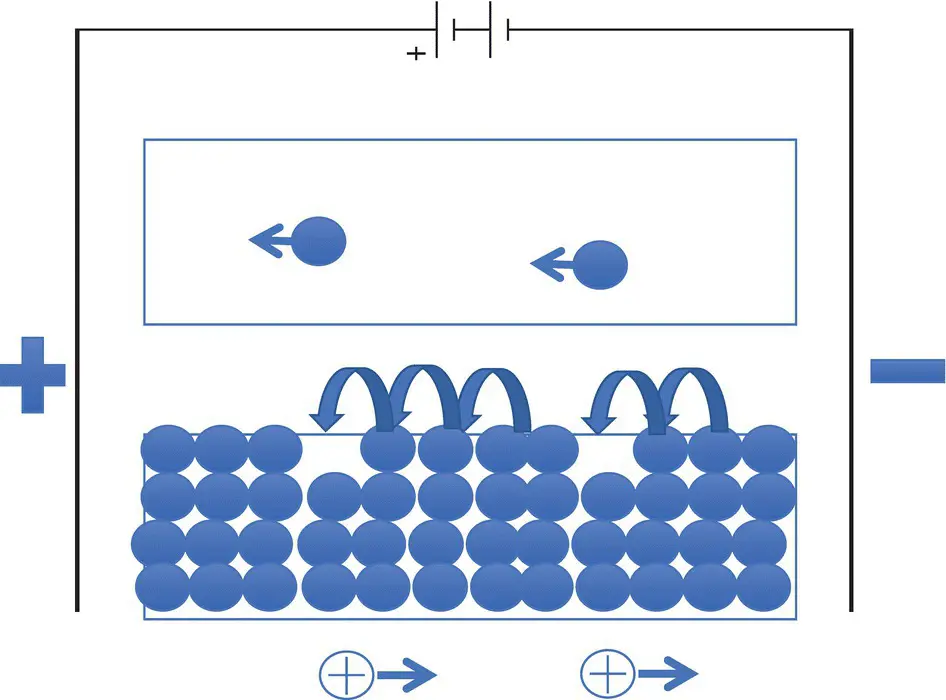In the same graph, I have the number of free charges in GaAs, the next‐most‐used semiconductor. Because the separation between the valence and conduction bands ( Eg ) in GaAs is larger than that of Si (1.43 eV vs. 1.12 eV), the number of free carriers in pure GaAs material is much lower than that of silicon, 1.79 × 10 6cm −3.
Remember this temperature dependence when we talk about the operation and use of semiconductor devices. When we turn on an electronic device, the temperature increases, and its electronic properties change. In Chapter 9, I discuss some of the tricks that designers use to stabilize circuits.
2.5 Digression: Water Analogy
Suppose you have a large pot of water sitting on the counter at room temperature (25 °C). The water is not moving. Now you place the pot on the stove and increase the temperature to 100 °C, the temperature of boiling water. There are three possibilities:
1 The rim of the pot is much higher than the level of the water. The boiling water remains in the pot. The rim is too high for the water to boil over.
2 The water fills the pot all the way to the top. As soon as the water starts boiling, water spill all over the stove.
3 Now consider an intermediate case. The water level is high, but it does not reach the rim. How much water spills over depends very much on the distance between the original water level and the rim of the pot. The larger the distance between the water level and the rim of the pot, the more water will spill from the pot.
You can immediately recognize the analogy. First, the separation of the water level and the rim of the pot is analogous to the energy gap. Case 1 is the insulator, where there is a large distance between the electrons and the empty conduction band. Case 2 is the conductor, where the electrons start spilling into the conduction band as soon as there is any energy at all. Finally, case 3 is the semiconductor, where the number of electrons in the conduction band depends on the separation between bands. There are more free electrons in silicon at room temperature than in GaAs because the separation of bands is much larger in GaAs.
I hope the analogy helps you understand the effect of the bands in defining the conductive processes of different materials. If you had difficulty in the previous sections, it might be worthwhile to go back and read them again.
2.6 The Mobility of Charges
Without going into detail, I would like to introduce the concept of mobility. Mobility , with the symbol μ , is basically a measure of how easy it is for electrons and holes to move: the opposite of resistance. Look at Figure 2.10. An electron in the conduction band without any impediments, like a car on the freeway, can move quite easily. The hole has more problems moving. Electrons in the valence band have to hop from one atom to an adjacent one that has empty space at the left. The next electron in line can jump to the empty space that the previous electron left behind, and so on. To an external viewer, a positive charge is moving to the right. You can intuitively see that electron motion is easier than hole motion.

Figure 2.10 Electrons in the conduction band are free to move, while those in the valance band have to hop to the closest atom that is missing an electron, which means the mobility of electrons in the conduction band is higher than that of holes (electrons in the valence band).
The mobility of electrons in silicon is μ n= 1400 cm 2/( V × s ), while the mobility of holes is only μ p= 450 cm 2/( V × s ). For the same applied voltage, the electrons in silicon are more than three times faster than the holes. This makes a lot of sense, and it is true for all semiconductors.
2.7 Summary and Conclusions
In this chapter, we have seen how as we shrink the interatomic distance between atoms, due to the Pauli exclusion principle the gaseous energy levels spread and become bands. We call the lowest energy band that has electrons the valance band and the one above it, empty of electrons, the conduction band . Depending on how many electrons are in the valence band and how far the valence and conduction bands are separated, we have conductors, insulators, or semiconductors.
At absolute zero, the valence band of a semiconductor is completely full, and the conductions band is empty. The separation between the bands is small. At room temperature, there is quite a bit of thermal energy, and a very small number of electrons have sufficient energy to move to the conduction band – and they are free to move. In the valence band, the missing electrons leave a hole that acts as if it were a positive charge.
The key concepts in this chapter that you need to understand to proceed to the next chapter are as follows:
The concepts of a valence band and a conduction band.
The concept that a small energy gap is required for an electron to move to the conduction band.
The concept of the hole – an atom missing an electron, which, under an applied voltage, accepts an electron from a neighboring atom, thus moving the hole toward the negative terminal as if it were a positive charge.
If you are comfortable with these concepts, you are ready to go to the next chapter.
Appendix 2.1 Energy Gap in Semiconductors
Semiconductors have different energy gaps measured in electron‐volts (eV), the energy of an electron under an applied voltage of 1 V ( Figure 2.11). As you may expect, an electron‐volt is a very small amount of energy ( e = 1.602 × 10 −19coulombs). The energy gaps of the most commonly used semiconductors – germanium, silicon, and gallium arsenide – are 0.67, 1.12, and 1.43 eV, respectively. Silicon is the most commonly used because it is easier to grow as pure crystals with no (or an insignificant number of) impurities and imperfections, and it is also easier to inject a controlled number of impurities. In the next chapter, I discuss why purity and the ability to add a controlled number of impurities are so important.

Figure 2.11 There is a large difference in energy gaps in semiconductors, from a very low value for InSb (0.17 eV) to GaAs (1.43 eV). Notice that the energy gap changes slightly as the temperature changes: about 5% for silicon between absolute zero and room temperature.
There is an interesting website with a huge amount of information on the elements: http://periodictable.com/Elements/050/data.html. Clicking any element in the periodic table will tell you its properties. Furthermore, if you click any property, it will tell you the value of that property for all the elements in the periodic table. It is interesting to see, using this website, that the great majority of elements are conductors. According to this site, of all the elements in the periodic table, 76 are conductors, 5 are insulators, and only 3 are semiconductors: Si, Ge, and Te. Te has an energy gap of 0.45 eV. The rest of the elements are either gases or have unknown values.
Appendix 2.2 Number of Electrons and the Fermi Function
To help you better understand how many electrons and holes are free in a material, let me state, without a proof, the Fermi–Dirac function. Enrico Fermi (1901–1954) was an Italian physicist who emigrated to the United States in 1938 to escape the persecution of Jews (his wife was Jewish). Paul Dirac (1902–1984) was a British scientist. These two physicists did a huge amount of work on quantum theory ( Figure 2.12).
Читать дальше













